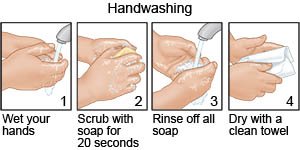Catheter-Associated Urinary Tract Infection
Medically reviewed by Drugs.com. Last updated on Apr 6, 2025.
What is a catheter-associated urinary tract infection (CAUTI)?
A CAUTI is an infection caused by an indwelling urinary catheter. The infection is caused by germs that do not usually live in the urinary tract. The germ can be a fungus or bacteria. Germs may get into the urinary tract when the catheter is being put in or while the catheter stays in the bladder. The infection may travel along the catheter and into the bladder or kidneys.
What increases my risk for a CAUTI?
- Being female
- Older age
- Certain diseases such as diabetes
- Chronic illness
- Having an indwelling urinary catheter for longer than 48 hours
What are the signs and symptoms of a CAUTI?
- Fever and chills
- Pain in your lower abdomen or back
- Bad-smelling, cloudy, bloody, or dark urine
- Burning during urination or frequent urination after the catheter is removed
- Sudden, strong need to urinate
- Confusion in older adults
- Weakness
How is a CAUTI diagnosed?
- A urinalysis will give information about your urinary tract and overall health.
- A urine culture may show the type of germ causing the infection.
- Blood tests will show infection and kidney function.
How is a CAUTI treated?
- Medicines may be given to treat an infection or decrease pain and fever.
- Catheter removal or change may help get rid of the infection.
How can I manage my symptoms?
- Drink liquids as directed. Liquids can help flush bacteria from your urinary tract. Ask how much liquid to drink each day and which liquids are best for you. You may need to drink more liquids than usual to help flush out the bacteria. Do not drink alcohol, caffeine, and citrus juices. These can irritate your bladder and increase your symptoms.
- Keep the catheter area clean. Clean your skin around the catheter as directed. Shower once a day. Do not take baths or go in hot tubs until your infection is gone.
- Do not have sex until your healthcare provider says it is okay. Sex may delay healing or cause another UTI.
How can I help prevent a CAUTI?
- Wash your hands before and after you use the bathroom or touch the catheter. Wash your hands to prevent the spread of infection to your urinary tract.

- Clean all parts of your catheter as directed. Keep your catheter tubing clean. Do not place the catheter on the ground. Do not allow the drainage spout to touch the toilet. Use an alcohol swab to clean the end of drainage spout as directed.
- Keep the drainage bag below your waist. This will prevent urine from moving back into your bladder, which can cause an infection.
- Empty the urine bag as directed. This may prevent urine from moving back into your bladder.
- Women should wipe front to back after a bowel movement. This may prevent germs from getting into the urinary tract.
- Keep the catheter secured to your leg as directed. Use tape or a special catheter holder to prevent your catheter from being pulled. This may also prevent kinks that could cause the urine to move back into the bladder.
When should I seek immediate care?
- You have severe pain in your lower back or abdomen.
- You have blood in your urine.
- You stop urinating, or you urinate much less than usual.
When should I call my doctor?
- You have a fever.
- Your symptoms do not improve or get worse.
- You have questions or concerns about your condition or care.
Care Agreement
You have the right to help plan your care. Learn about your health condition and how it may be treated. Discuss treatment options with your healthcare providers to decide what care you want to receive. You always have the right to refuse treatment. The above information is an educational aid only. It is not intended as medical advice for individual conditions or treatments. Talk to your doctor, nurse or pharmacist before following any medical regimen to see if it is safe and effective for you.© Copyright Merative 2025 Information is for End User's use only and may not be sold, redistributed or otherwise used for commercial purposes.
Further information
Always consult your healthcare provider to ensure the information displayed on this page applies to your personal circumstances.
